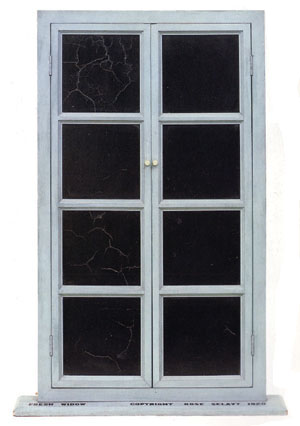
Fresh Widow
 |
| Original version? 1953 |
|
Original Version:
1920, New York |
Made by a New York carpenter according to Duchamp's specifications, this Readymade (like many others) questions the nature of authorship (Ades 164). There is a very pronounced separation between the artist and the art object in this case. As Nesbit writes, "So the design is repeated and manufactured like a model for a patent-office" (63). However, it is important to note the major difference between this piece and more pure Readymades such as Bottle Rack: here Duchamp creates this distance himself. He consciously assigned the creation of the object to someone else as opposed to walking into a shop and buying something pre-made without him in mind. Also, Fresh Widow could not be functional to begin with because (1) it is not to size, but purposely miniaturized and (2) the viewer cannot look through its panes.
The authorship question does not stop with the basic form and production of this Readymade. Inscribed on the bottom with "Copyright Rose Selavy, 1920," the window suddenly has yet another artist. The first Duchamp piece signed by his transsexual alter ego, this Readymade not only illustrates a further complexity in authorship, but also shows evidence of linguistic manipulation and a gendered meaning. Inscribed across the sill in black paper-tape letters is the following: "FRESH WIDOW COPYRIGHT ROSE Selavy 1920."
The name "Rose Selavy" (later to adapt into the final "Rrose Selavy") is a play on the well-known French phrase "Eros, c'est la vie," meaning "Love, that's life!" Meanwhile, by incorporating the term "Copyright" in this signature of sorts, Duchamp brings this piece into a whole different realm. As Nesbit points out in the following excerpt:
As mentioned above, this miniature version of a French window is clearly very different from its prototype. Most obviously, the viewer cannot see through the glass panes for they are covered over with black leather. This ties in very closely with a gendered interpretation of this Readymade. The intriguing title functions as a linguistic punning on the term "French Window." By simply switching out and changing several letters in this phrase, the viewer is forced to see the sexual nature of the piece, complete with its secretive covered over panes. Together this mysterious covering and the title Fresh Widow lead to the personification of the window as a female body. Cook has developed an in-depth interpretation of this personification as follows:
Also, if a grieving widow whose nose was stuffed up tried to say "French window," what very well might come out would be "fresh widow" (Cook 264). Cook emphasizes that all of these possibilities are "qualified by literary law and the transvestite mockery in the inscription at the bottom of the window" (264). Nesbit alludes to her support of a similar interpretation when she notes that Fresh Widow "makes a joke at the expense of the French war widow" (63). Nowhere did the author find a comment on the blue coloration of the window frame; one must wonder, based on elemental color theory ideas, whether this, too, could be a reference to the "blue" or "sad" emotional state of the widow/window.
When approaching this complex Readymade, the viewer must be aware that interpretations overlap and play with each other. The viewer needs to be aware of other twists that have been introduced into the discourse (especially since some of them have been proposed by the artist himself). Schwarz notes that the colloquial term in French for guillotine is "la veuve" or "widow" in English, therefore pointing to Fresh Widow's allusion to the castration complex. He also explains that the window is a classic ambivalent sexual symbol that, according to Freud, stands for the "body's openings" (205). Also, in a 1966 interview with Cabanne, Duchamp noted that "fresh" means "smart," thus simultaneously adding to the personification already discussed and alluding to the wittiness of the Readymade (Cabanne 66).
Replicas:
2) 1964, Milan

Original version?, 1953 (reverse side) "Duchamp has claimed a copyright for a window that is not only plagiarized but by definition not eligible for copyright: the window is an industrial good in the eyes of the law; if suitably innovative it might be patented but never given the "droit d'auteur," not even in America. The copyright [in keeping with Duchampian style overall of course] was a bluff" (63). ([]ed text the author's.) "The widow is in mourning, and she is also the opposite of a transparent window; nobody knows what is happening inside her, and yet she might be inferred to be entering the widow's scandalously proverbial state of sexual readiness, a reading that the veterinary sense of 'fresh' would reinforce" (264).
1) 1961, Stockholm
Moderna Museet, Stockholm
Gift of Ulf Linde, 1961
Made by Ulf Linde, 77 x 51.8 x 10.5 cm
Edition of eight, identical in size to original, made under Duchamp's supervision
Inscribed on back in black ink: "Marcel Duchamp 1964"
Copper plate affixed to base: "Marcel Duchamp 1964 1/8-8/8" "FRESH WIDOW, 1920 / EDITION GALERIE SCHWARZ, MILAN", and black paper-tape letters on base like on original
Two outside the edition for the artist and publisher, and two more for the exhibition